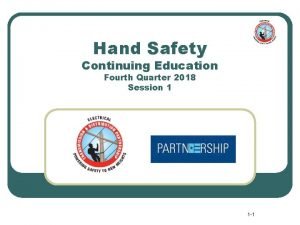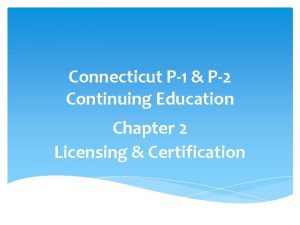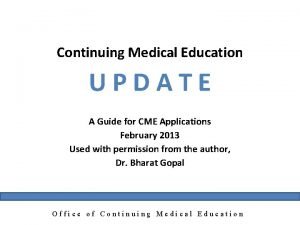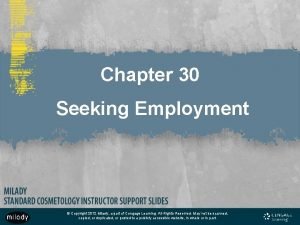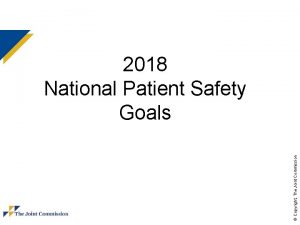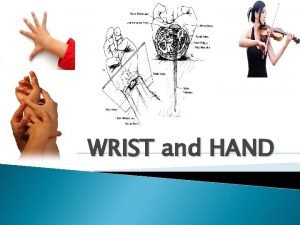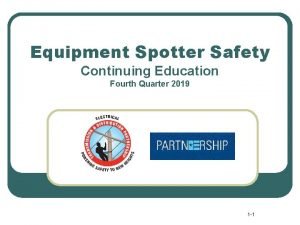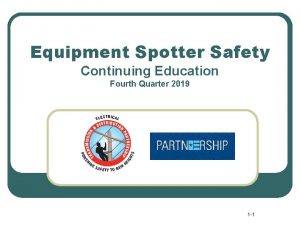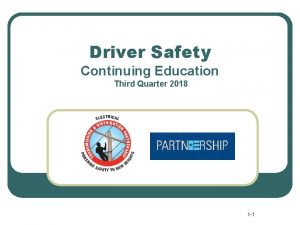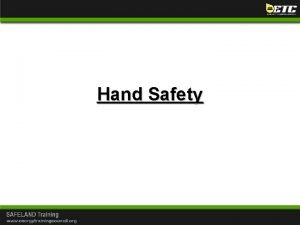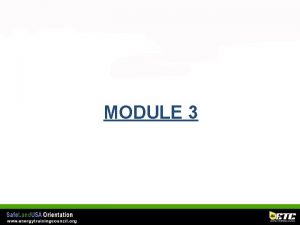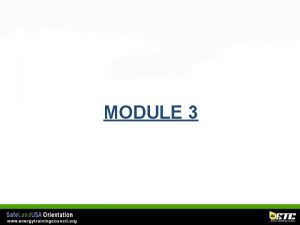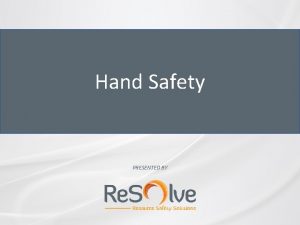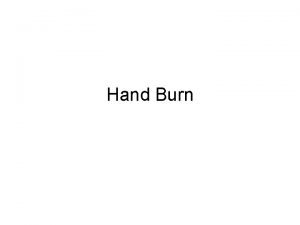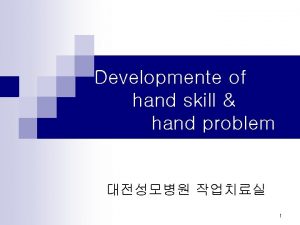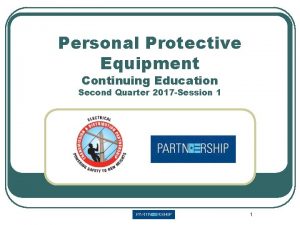Hand Safety Continuing Education Fourth Quarter 2018 Session
































- Slides: 32

Hand Safety Continuing Education Fourth Quarter 2018 Session 1 1 -1

Objectives Upon completion of this continuing education module you should be able to: þ Describe the effects of hand injuries þ Explain employer responsibilities regarding hand protection þ Explain hand injury prevention þ Explain workplace hazards that require hand protection þ Select appropriate hand protection based on exposure 1 -2

Your Hands are one of the most complex body parts ü ü They help us to be a skilled, valuable worker Used in almost everything we do 1 -3

Take Care of Your Hands Use personal hygiene ü ü Small cuts may become infected Report All Hand Injuries Wear Your Gloves Protect your hands 1 -4

Hand Injury Facts nd Leading Cause of 2 The average hand Workplace injuries injury claim has 110, 000 lost time hand now exceeded injuries per year $6, 000, with ü Average time missed, 6 individual days workers’ ü 70% of workers that compensation experience hand injuries were not wearing gloves claims reaching nearly $7, 500 ü 1 -5

Bureau of Labor Statistics Hand injuries accounted for 40 percent of all upper extremity injuries l The most among all upper extremity injuries 1 -6

Why the Focus on Hands? Partnership Total Hand Injury Events 164 • Workers on ground level 113 • Working in an Aerial Device 16 • Working while on a vehicle 12 • Lineman 42 • Apprentice Lineman 31 • Working with knives 26 1 -7

It is a Mind Set Responsibility • We are all responsible for not engaging in unnecessary risk at work Accountability • Tools, pinch points and stored energy WILL hold us accountable whether we like it or not Authority • You are authorized by your company to STOP WORK if necessary to address hazards 1 -8

Control Hand Injuries Methods: ü Tailboards ü JHA’s ü Work Practices ü Correct Tools ü Training 1 -9

Impact of Hand Injuries If you injured or lost your thumb how would you: Tie Your Shoes ü Button Your Shirt ü Sign Your Name ü Use Silverware ü Change a Fishing Lure ü Throw a Baseball ü 1 -10

Key Points-Session One 1. 2. 3. Hand injuries account for _____ of all upper extremity injuries. a. 10% b. 20% c. 30% d. 40% The average hand injury results in an average ______ lost work days. a. 3 b. 6 c. 9 70% of people that experienced hand injury were not wearing gloves. a. True b. False 1 -11

Hand Safety Continuing Education Fourth Quarter 2018 Session 2 2 -1

Typical Incidents Hand injuries can be divided into six general categories ü ü ü Lacerations Fractures and Dislocations Soft tissue injuries and Amputations Infections Burns High pressure injuries 2 -2

Knives Avoid use if possible and consider an alternative ü ü ü Keep blades sharp Cut away from you Never pry or twist Wear cut resistant gloves Change blades carefully Close, retract, or sheath when not in use 2 -3

Pinch Points Recognize pinch points ü ü ü Stay focused Use tag lines Stay out of the Bite Proper LOTO Use something other than your hands 2 -4

Chemical Hazards Chemical exposure ü ü Consult the SDS Substitute Products Follow Instructions Use the Right Protection 2 -5

Electrical Hazards Safe Work Practices ü ü ü ü Plan the Work De-energize, Test and Ground Use Insulated Tools Maintain Minimum Approach Distance Insulate/Isolate Second Points of Contact Use Rated PPE 2 -6

Tools Identify and Use the Best Tool for the Job ü ü ü Follow Manufacturer’s Recommendations Ensure Proper Training Inspect and Keep Tools in Good Condition Never Modify a Tool Maintain Control of Tool 2 -7

Repetitive Motion Injuries Caused By Doing the Same Hand or Wrist Movements for Prolonged Periods üPain üNumbness üTingling üCramping üLoss of Grip Strength Report to a Supervisor Immediately ü Stretching, Icing and Rest may help 2 -8

Key Points-Session Two 1. 2. 3. When using a knife, always cut ______ from your body. a. Toward b. Away The key to avoiding pinch-point injuries is to avoid pinch–points all together. a. True b. False Repetitive motion injuries can occur when a person performs the same hand/wrist movements for prolonged periods. a. True b. False 2 -9

Hand Safety Continuing Education Fourth Quarter 2018 Session 3 3 -1

Hand Protection Planning for Hand Protection Pre-Bid risk analysis ü Perform an analysis of the task ü Selection of hand protection Keep in mind that wearings, watches, or bracelets can cut/tear gloves and create other additional hazards ü Must be provided by the employer ü 3 -2

Leather Gloves Provides protection from rough surfaces ü ü ü Many styles to pick from Generally available insulated for cold conditions Very cost effective Good for most hand hazards May not provide adequate cut protection 3 -3

Cut Resistant Gloves Prevent or reduce cuts from knives or sharp edges. ü Cut RESISTANT, not Cut PROOF! ü Offer little protection from pinch points or punctures ü Available in cut levels 1 -5 ü Level 5 offers best protection 3 -4

Chemical Resistant Prevent direct contact with chemicals ü ü ü No glove will protect from ALL chemicals Chemicals will break down the glove material over time The thicker the glove, the more resistant it is to chemicals 3 -5

Anti-Vibration Gloves Reduce the effects of excessive vibration ü ü Have padding in palms and fingers Help absorb the vibration Reduces but does not eliminate Bulky 3 -6

Impact Resistant Gloves Provide added protection from crushing injuries ü ü Impact absorbing rubber ribs and padding designed into gloves Usually have a cut resistant rating as well Provides good dexterity and grip Best overall option in a glove 3 -7

Insulated Rubber Gloves Voltage rated ü ü ü Must be electrically tested and stamped Inspected before use Used in conjunction with leather protective covers 3 -8

Class AC proof test Voltage Maximum AC Use Voltage 00 2, 500 0 5, 000 1 10, 000 7, 500 2 20, 000 17, 000 3 30, 000 26, 000 4 40, 000 36, 000 3 -9

Length One inch of rubber past the top of protector for each k. V class rating Class Distance 1 1 inch 2 2 inches 3 3 inches 4 4 inches 3 -10

Strengths & Limitations Protective equipment can protect the user ü Must inspect it ü Must be rated for the hazard ü Must be used 3 -11

Key Points-Session Three 1. 2. 3. Cut resistant gloves are also cut and puncture proof. a. True b. False 30 k. V rated rubber insulating gloves must have ____ inches of rubber past the cuff a. 2 b. 3 c. 4 Rings, watches, or bracelets can cut/tear gloves and create other additional hazards a. True b. False 3 -12
 Hand safety presentation 2018
Hand safety presentation 2018 Clock showing quarter past 10
Clock showing quarter past 10 Half past 15
Half past 15 San diego continuing education north city campus
San diego continuing education north city campus Texas professional engineer continuing education
Texas professional engineer continuing education Imslec continuing education
Imslec continuing education Stanford continuing studies certificate
Stanford continuing studies certificate Kylene perras uconn
Kylene perras uconn Connecticut plumbing license
Connecticut plumbing license Esp uq
Esp uq Nj institute for continuing legal education
Nj institute for continuing legal education Georgia professional engineer
Georgia professional engineer Cara belajar orang dewasa
Cara belajar orang dewasa Oxford continuing education
Oxford continuing education Dlgf(dlgf)continuing education/webinars
Dlgf(dlgf)continuing education/webinars Rewley house continuing education library
Rewley house continuing education library Fclb pace
Fclb pace Bladen community college online classes
Bladen community college online classes Uic cme
Uic cme Aafp metric
Aafp metric Chapter 32 the salon business milady answers
Chapter 32 the salon business milady answers Continuing medical education
Continuing medical education Importance of continuing education
Importance of continuing education Iec dallas
Iec dallas Aea continuing education
Aea continuing education B a f c j e
B a f c j e National patient safety goal 6
National patient safety goal 6 National patient safety goal 6
National patient safety goal 6 Hand of benediction nerve
Hand of benediction nerve Whats a quarter past 7
Whats a quarter past 7 Mother father sister brother
Mother father sister brother Method study flow process chart
Method study flow process chart Im abendrot eichendorff interpretation
Im abendrot eichendorff interpretation
